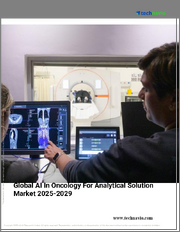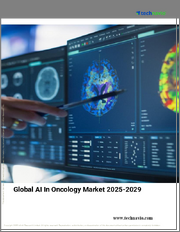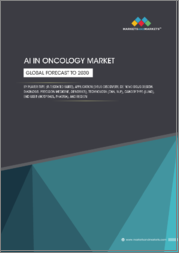
|
시장보고서
상품코드
1821504
종양학 AI 시장 : 업계 동향과 세계 예측(-2035년) - 암 유형별, 최종사용자 유형별, 지역별AI in Oncology Market: Industry Trends and Global Forecasts, Till 2035 - Distribution by Type of Cancer, Type of End User, Geographical Regions |
||||||
종양학 분야 AI 시장 : 개요
종양학 분야 AI 시장 규모는 현재 24억 달러에서 2035년까지 91억 달러로 성장할 것으로 추정되며, 예측 기간 동안 14.1%의 높은 CAGR을 나타낼 것으로 예측됩니다.
시장 세분화 및 기회 분석은 다음과 같은 매개 변수로 세분화됩니다.
암 유형별
- 고형 악성 종양
- 유방암
- 폐암
- 전립선암
- 대장암
- 뇌종양
- 기타
최종 사용자 유형별
- 병원
- 제약회사
- 연구기관
- 기타
지역별
- 북미
- 유럽
- 아시아태평양
- 기타 지역
종양학 분야 AI 시장 : 성장과 동향
AI는 제약 산업에서 데이터 수집, 평가, 실시간 해석에 크게 활용되고 있습니다. 실제로 AI 기반 소프트웨어 솔루션의 통합을 통해 임상의는 암을 조기에 발견하고 다양한 종양학적 적응증을 치료할 수 있는 맞춤형 치료법을 개발할 수 있습니다. 또한, 종양학 분야 AI 기반 기술은 암 검사 및 치료 비용을 크게 절감할 수 있습니다. AI 기술이 제공하는 의미에 힘입어 전문가들은 종양학에서 AI를 사용하는 것이 향후 수익을 창출할 수 있는 엄청난 잠재력을 가지고 있다고 보고 있습니다.
세계적으로 암 발생 위험이 증가함에 따라 환자 치료를 위한 첨단 암 진단 및 치료 방법에 대한 수요가 크게 증가하고 있습니다. 암이 전 세계 사망 원인 1위라는 것은 널리 알려진 사실입니다. 또한, 국제암연구소는 2030년까지 암으로 인한 사망자 수가 72% 증가할 가능성이 높다고 예측했습니다. 따라서 기술 혁신과 암 발병률 증가와 같은 시장 성장 촉진요인이 종양학 분야 AI 시장을 혁신적으로 성장시키고 있습니다. 그러나 규제 장벽과 데이터 프라이버시 등의 문제를 극복하는 것이 향후 몇 년 동안 그 잠재력을 최대한 발휘하는 데 있어 중요한 과제가 될 것으로 보입니다.
종양학 분야 AI 시장 주요 인사이트
이 보고서는 종양학 분야 AI 시장 현황을 살펴보고 업계 내 잠재적인 성장 기회를 파악합니다. 본 보고서의 주요 조사 결과는 다음과 같습니다.
- 현재 시장 상황은 종양학 분야를 위한 AI 기반 소프트웨어 솔루션 개발에 종사하는 70여 개 이상의 기업이 진입하고 있는 것이 특징입니다.
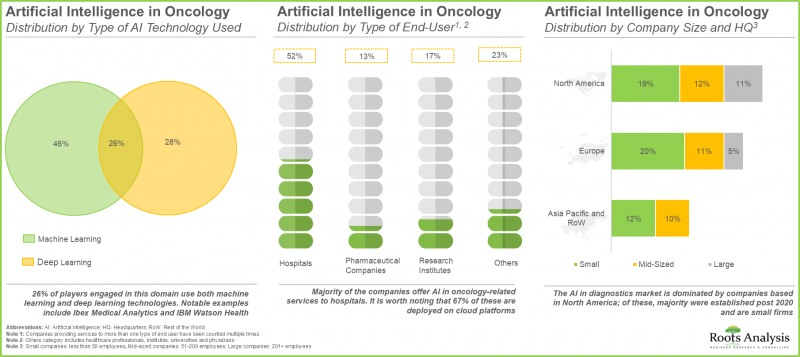
- 50% 이상의 진입기업이 병원에서 진단 목적으로 머신러닝을 활용한 솔루션을 사용하고 있습니다.
- 경쟁 우위를 확보하기 위해 업계 이해관계자들은 기존 역량을 적극적으로 업그레이드하고 AI에 초점을 맞춘 서비스 포트폴리오를 강화하고 있습니다.
- 이 시장에 대한 관심이 높아진 것은 최근 파트너십 활동이 활발해진 것에서도 알 수 있습니다.
- 많은 공공 및 민간 투자자들이 수익률을 기대하며 60억 달러 상당의 투자를 하고 있습니다.
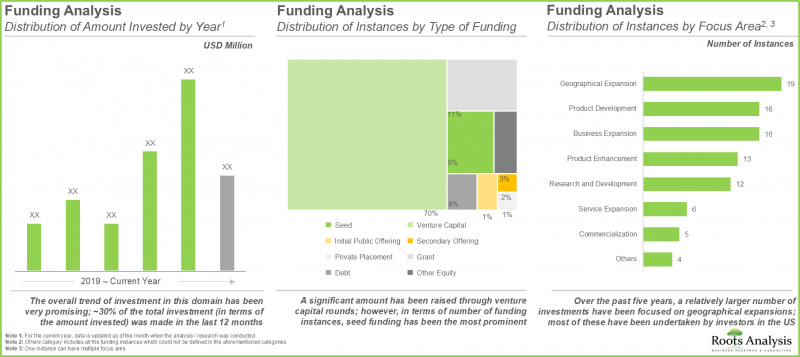
- 지난 5년간 학계 및 산업계 이해관계자들이 종양학용 AI 기반 소프트웨어 솔루션 개발에 전념하여 2,770건 이상의 특허를 출원/출원했습니다.
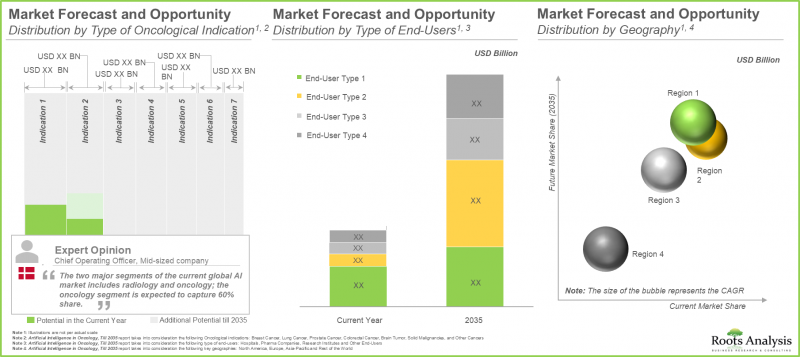
- 이 시장은 향후 10년간 14.1%의 건전한 성장이 예상되며, 그 기회는 다양한 적응증, 분자 유형, 다양한 지역으로 잘 분산될 가능성이 높습니다.
암 분야 인공지능 시장 : 주요 부문
암종별로는 고형암, 유방암, 폐암, 전립선암, 대장암, 뇌종양 등으로 구분하여 세계 종양학 AI 시장을 분류합니다. 올해도 고형암 분야가 시장 점유율의 대부분을 차지할 것으로 예상되며, 이러한 추세는 앞으로도 변하지 않을 것으로 보입니다. 이러한 높은 시장 점유율은 특히 고형암의 전 세계 암 부담 증가로 인해 혁신적이고 확장 가능하며 정밀한 도구가 필요하기 때문에 이 분야에서 가치 있는 AI 용도를 창출하고 있습니다.
최종 사용자 유형에 따라 시장은 병원, 제약회사, 연구기관, 기타로 분류됩니다. 현재 병원 부문이 종양학 분야 AI 시장에서 가장 큰 점유율을 차지하고 있습니다. 이러한 추세는 가까운 미래에도 변하지 않을 것으로 보입니다.
지역별로 세계 종양학 AI 시장은 북미, 유럽, 아시아태평양, 기타 지역으로 구분됩니다. 당사의 조사에 따르면, 현재 유럽이 종양학 분야 AI 시장 점유율의 대부분(33%)을 차지하고 있으며, 이러한 추세는 앞으로도 변하지 않을 것으로 보입니다. 이는 인구 고령화, 고급 암 진단의 필요성 증가, 만성질환 관리 분야 증가에 따른 결과이며, AI 솔루션은 실질적인 투자를 제공합니다. 또한, 아시아태평양 시장은 2035년까지 예측 기간 동안 비교적 높은 CAGR(14.7%)로 성장할 가능성이 높습니다. 이는 이 지역의 암 환자 수가 증가함에 따라 첨단 진단 및 치료 솔루션에 대한 수요가 증가하고 있기 때문입니다.
1차 조사 개요
본 조사에서 제시된 의견과 통찰력은 여러 이해관계자와의 논의를 통해 영향을 받은 것입니다. 조사 보고서에는 다음과 같은 업계 관계자와의 인터뷰 기록이 상세하게 수록되어 있습니다.
- A사 대표이사
- B사 CEO
- C사 최고 경영자
- D사 마케팅 커뮤니케이션 담당 부사장
종양학 분야 AI 시장 진출기업 사례
- Berg(BPGbio의 일부)
- CancerCenter.AI
- Concert AI
- GE Healthcare
- IBM Watson Health
- iCAD
- JLK Inspection
- Median Technologies
- Path AI
- Roche Diagnostics
종양학 분야 AI 시장 조사 대상
- 시장 규모 및 기회 분석 본 보고서에서는 세계 종양학 AI 시장을(A) 생산되는 항체의 유형,(B) 암 유형,(C) 최종 사용자 유형,(D) 지역 등 주요 시장 부문별로 심층 분석합니다.
- 시장 상황:(A) 설립연도,(B) 기업 규모,(C) 본사 소재지,(D) 최종 사용자 유형,(E) 제공하는 서비스 유형,(F) 사용하는 AI 기술 유형,(G) 플랫폼 유형 등 여러 관련 파라미터를 기반으로 종양학 AI 시장 관련 기업을 상세하게 평가합니다. 평가합니다.
- 경쟁 분석 : A) 기업의 강점,(B) 포트폴리오의 강점 등의 요인을 검증하여 종양학 분야 AI 솔루션 제공업체에 대한 종합적인 경쟁 분석을 수행합니다.
- 기업 프로파일:(A) 기업 개요,(B) 재무 정보(가능한 경우),(C) 서비스 포트폴리오,(D) 최근 동향 및 미래 전망에 초점을 맞춘 종양학 분야 AI 시장에 종사하는 주요 서비스 제공업체의 상세한 기업 프로파일.
- 특허 분석 :(A) 특허 공개 연도,(B) 특허 유형,(C) 특허 관할권,(D) CPC 기호,(F) 출원인 유형,(G) 관할권,(H) 주요 진출기업,(i) 벤치마킹 분석,(J) 특허 평가 등 다양한 관련 파라미터를 바탕으로 종양학 AI 시장 영역에서 현재까지 출원/취득된 특허를 상세하게 분석합니다.
- 파트너십 및 분석 : A) 파트너십 체결 연도, B) 파트너십 유형, C) 암 유형, D) 가장 활발한 참여 기업(파트너십 체결 수), E) 파트너십 활동의 지역 분포 등 여러 매개 변수를 기반으로 종양학 AI 시장 이해관계자 체결한 거래에 대한 통찰력 있는 분석.
- 자금조달 및 투자 분석 : A) 자금조달 연도, B) 연도별 투자금액, C) 자금조달 유형, D) 기업 규모별 투자금액, E) 투자자 유형, F) 투자자 유형별 투자금액, G) 가장 활발한 진출기업, H) 가장 활발한 투자자, i) 지역 분석 등 관련 매개변수를 바탕으로 AI가 신약개발 기업에서 조달한 자금을 상세하게 분석합니다.
- 블루오션 분석 : A) 가치혁신, B) 전략 캔버스, C) 4가지 액션 프레임워크, D) ERRC 그리드, E) 6가지 경로 프레임워크, F) 파이오니어-마이그레이터-세틀러(PMS) 맵, G) 비고객의 3계층, F) 블루오션 전략 시퀀싱,(F) 구매자 유틸리티 맵 등 다양한 프레임워크에 따라 진입기업을 평가합니다.
목차
제1장 서문
제2장 주요 요약
제3장 서론
- 본 장의 개요
- 인공지능 개요
- 인공지능 유형
- 헬스케어 AI
- 헬스케어 분야 AI활용에 수반하는 주요 과제
- 향후 전망
제4장 시장 개요
- 본 장의 개요
- 종양학 AI : 소프트웨어 프로바이더 시장 구도
- 종양학 AI : 소프트웨어 솔루션 시장 구도
제5장 기업 개요
- 본 장의 개요
- Roche Diagnostics
- IBM Watson Health
- CancerCenter.AI
- GE Healthcare
- Concert AI
- Path AI
- Berg
- Median Technologies
- iCAD
- JLK Inspection
제6장 기업 경쟁력 분석
- 본 장의 개요
- 전제와 주요 파라미터
- 조사 방법
- 기업 경쟁력 : 북미 중소기업
- 기업 경쟁력 : 유럽 중소기업
- 기업 경쟁력 : 아시아태평양 중소기업
- 기업 경쟁력 : 북미 중규모 기업
- 기업 경쟁력 : 유럽 중규모 기업
- 기업 경쟁력 : 아시아태평양 중규모 기업
- 기업 경쟁력 : 북미와 유럽 대기업
제7장 특허 분석
- 본 장의 개요
- 범위와 조사 방법
- 종양학 AI : 특허 분석
- 종양학 AI : 특허 벤치마킹 분석
제8장 파트너십 및 협업
- 본 장의 개요
- 파트너십 모델
- 종양학 AI : 최근 파트너십 및 협업
제9장 자금조달과 투자 분석
- 본 장의 개요
- 자금조달 모델 유형
- 종양학 AI : 자금조달과 투자 분석 리스트
- 투자 요약
- 결론
제10장 블루 오션 전략 : 경쟁 격렬한 시장에 참여 하는 스타트업을 위한 전략 가이드
- 본 장의 개요
- 블루 오션 전략 개요
- 결론
제11장 시장 규모 평가와 기회 분석
- 본 장의 개요
- 주요 전제와 조사 방법
- 종양학 AI 시장, 2022년-2035년
- 종양학 AI 시장 : 암 유형별 분석, 2022년-2035년
- 종양학 AI 시장 : 최종사용자 유형별 분석, 2022년-2035년
- 종양학 AI 시장 : 주요 지역별 분석, 2022년-2035년
제12장 결론
제13장 경영진 인사이트
제14장 부록 1 : 표 형식 데이터
제15장 부록 2 : 기업 및 단체 리스트
LSH 25.09.30Ai in Oncology Market: Overview
The AI in oncology market is estimated to grow from USD 2.4 billion in the current year to USD 9.1 billion by 2035, representing a higher CAGR of 14.1% during the forecast period.
The market sizing and opportunity analysis has been segmented across the following parameters:
Type of Cancer
- Solid Malignancies
- Breast cancer
- Lung cancer
- Prostate cancer
- Colorectal cancer
- Brain tumor
- Others
Type of End User
- Hospitals
- Pharmaceutical Companies
- Research Institutes
- Others
Geographical Regions
- North America
- Europe
- Asia-Pacific
- Rest of the World
Ai in Oncology Market: Growth and Trends
AI has been immensely utilized for data collection, evaluation, and real-time interpretation in the pharmaceutical industry. In fact, the integration of AI-based software solutions enables clinicians to detect cancer at an early stage and develop personalized therapies to treat a wide range of oncological indications. Additionally, AI-powered technology in oncology significantly reduces the cost of cancer testing and treatment. Driven by the significance offered by AI technology, experts believe that the use of AI in oncology market has enormous potential to generate revenue in the future.
Due to the rise in cancer risk across the globe, there has been a significant rise in the demand for advanced cancer diagnostic and treatment methods to treat patients. It is a widely known fact that cancer is the leading cause of deaths worldwide. Further, International Agency for Cancer Research suggests that the number of cancer-associated deaths is likely to increase by 72%, by 2030. Therefore, drivers such as technological innovation and rising cancer incidence position the AI in oncology market for transformative growth. However, overcoming challenges such as regulatory hurdles and data privacy would remain critical in realizing its full potential in the coming years.
Ai in Oncology Market: Key Insights
The report delves into the current state of the AI in oncology market and identifies potential growth opportunities within industry. Some key findings from the report include:
- The current market landscape features the presence of over 70 players engaged in the development of AI-based software solutions for the oncology sector.

- Over 50% of the players use their machine learning powered solutions for diagnostic purposes in hospitals; geographically, the software providers are well distributed.
- In pursuit of gaining a competitive edge, industry stakeholders are actively upgrading their existing capabilities and enhancing their AI-focused service portfolios.
- The growing interest in this market is prevalent from the recent rise in partnership activity; ~50% of the deals were inked to enable utilization and integration of proprietary AI-based technology solutions
- Foreseeing lucrative returns, many public and private investors have made investments worth ~USD 6 billion; 70% of the funding initiatives were led by venture capitalists.

- Over 2,770 patents have been granted / filed by academic and industry stakeholders in the last five years, exclusively for the development of AI-based software solutions for oncology.

- The market is expected to witness a healthy growth of 14.1% in the coming decade; the opportunity is likely to be well distributed across various target indications, types of molecules and different regions.
Ai in Oncology Market: Key Segments
Solid Malignancies Holds the Largest Share
Based on the type of cancer, the global AI in oncology market is segmented across type of cancer, such as solid malignancies, breast cancer, lung cancer, prostate cancer, colorectal cancer, brain tumor and others. The solid malignancies segment is likely to capture the majority of the market share in the current year, and this trend is unlikely to change in the future. The high market share can be attributed to the increased global cancer burden, particularly in solid tumors, which has necessitated innovative, scalable, and precise tools, thus creating valuable AI applications valuable in this sector.
Currently, Hospitals Segment Occupies the Largest Share of the AI in Oncology Market
Based on the type of end-user, the market is segmented into hospitals, pharmaceutical companies, research institutes and others. In the current year, the hospital segment holds the maximum share of AI in oncology market. This trend is unlikely to change in the near future.
Asia-Pacific to Propel in the AI in Oncology Sector in the Coming Years
Based on the geographical regions, the global AI in oncology market is segmented across North America, Europe and Asia-Pacific and rest of the world. Our research suggests that Europe captures the majority (33%) of AI in oncology market share in the current year and this trend is unlikely to change in the future. This is a result of the ageing population, rise in the need for advanced cancer diagnostics and chronic disease management areas, wherein AI solutions provide substantial investments. Further, the market in Asia-Pacific is likely to grow at a relatively high CAGR (14.7%), during the forecast period till 2035. This is attributed to the increase in the number of cancer cases in the region, driving demand for advanced diagnostic and treatment solutions.
Primary Research Overview
The opinions and insights presented in this study were influenced by discussions conducted with multiple stakeholders. The research report features detailed transcripts of interviews held with the following industry stakeholders:
- Chief Executive Officer, Company A
- Chief Executive Officer, Company B
- Chief Executive Officer, Company C
- Vice President, Marketing and Communications, Company D
Example Players in the AI in Oncology Market
- Berg (A part of BPGbio)
- CancerCenter.AI
- Concert AI
- GE Healthcare
- IBM Watson Health
- iCAD
- JLK Inspection
- Median Technologies
- Path AI
- Roche Diagnostics
Ai in Oncology Market: Research Coverage
- Market Sizing and Opportunity Analysis: The report features a thorough analysis of the global AI in oncology market, in terms of the key market segments, including [A] type of antibody manufactured, [B] type of cancer, [C] type of end user and [D] geographical regions.
- Market Landscape: An in-depth assessment of the companies involved in AI in oncology market, based on several relevant parameters, such as [A] year of establishment, [B] company size, [C] location of headquarters, [D] type of end-user, [E] type of services offered, [F] type of AI technology used, and [G] type of platform.
- Company Competitiveness Analysis: A comprehensive competitive analysis of AI in oncology solution providers, examining factors, such as [A] company strength and [B] portfolio strength.
- Company Profiles: Detailed profiles of key service providers engaged in the AI in oncology market, focused on [A] overview of the company, [B] financial information (if available), [C] service portfolio, and [D] recent developments and an informed future outlook.
- Patent Analysis: An in-depth analysis of patents filed / granted till date in the AI in oncology market domain, based on various relevant parameters, such as [A] patent publication year, [B] type of patent, [C] patent jurisdiction, [D] CPC symbols, [F] type of applicant, [G] jurisdiction, [H] leading players, [I] benchmarking analysis and [J] patent valuation.
- Partnerships and Analysis: An insightful analysis of the deals inked by stakeholders in the AI in oncology market, based on several parameters, such as [A] year of partnership, [B] type of partnership,[C] type of cancer, [D] most active players (in terms of the number of partnerships signed) and [E] geographical distribution of partnership activity.
- Funding and Investment Analysis: An in-depth analysis of the fundings raised by AI in drug discovery companies, based on relevant parameters, such as [A] year of funding, [B] amount invested by year, [C] type of funding, [D] amount invested by company size, [E] type of investor, [F] amount invested by type of investor, [G] most active players, [H] most active investors and [I] geographical analysis.
- Blue Ocean Analysis: A strategic guide for start-ups to enter into a highly competitive market, assessing players based on various frameworks, such as [A] value innovation, [B] strategy canvas, [C] four action framework [D] eliminate-raise-reduce-create (ERRC) grid [E] six path framework [F] pioneer-migrator-settler (PMS) map [G] three tiers of noncustomers [F] sequence of blue ocean strategy and [F] buyer utility map.
Key Questions Answered in this Report
- How many companies are currently engaged in this market?
- Which are the leading companies in this market?
- What factors are likely to influence the evolution of this market?
- What is the current and future market size?
- What is the CAGR of this market?
- How is the current and future market opportunity likely to be distributed across key market segments?
Reasons to Buy this Report
- The report provides a comprehensive market analysis, offering detailed revenue projections of the overall market and its specific sub-segments. This information is valuable to both established market leaders and emerging entrants.
- Stakeholders can leverage the report to gain a deeper understanding of the competitive dynamics within the market. By analyzing the competitive landscape, businesses can make informed decisions to optimize their market positioning and develop effective go-to-market strategies.
- The report offers stakeholders a comprehensive overview of the market, including key drivers, barriers, opportunities, and challenges. This information empowers stakeholders to stay abreast of market trends and make data-driven decisions to capitalize on growth prospects.
Additional Benefits
- Complimentary PPT Insights Packs
- Complimentary Excel Data Packs for all Analytical Modules in the Report
- 15% Free Content Customization
- Detailed Report Walkthrough Session with Research Team
- Free Updated report if the report is 6-12 months old or older
TABLE OF CONTENTS
1. PREFACE
- 1.1. Overview
- 1.2. Scope of the Report
- 1.3. Market Segmentation
- 1.4. Research Methodology
- 1.5. Key Questions Answered
- 1.6. Chapter Outlines
2. EXECUTIVE SUMMARY
- 2.1 Chapter Overview
3. INTRODUCTION
- 3.1. Chapter Overview
- 3.2. Overview of Artificial Intelligence
- 3.3. Types Of Artificial Intelligence
- 3.4. AI in Healthcare
- 3.5. Key Challenges Associated with Use of AI in Healthcare Sector
- 3.6. Future Perspectives
4. MARKET OVERVIEW
- 4.1. Chapter Overview
- 4.2. AI in Oncology: Market Landscape of Software providers
- 4.2.1. Analysis by Year of Establishment
- 4.2.2. Analysis by Company Size
- 4.2.3. Analysis by Location of Headquarters (Region-wise)
- 4.2.4. Analysis by Location of Headquarters (Country-wise)
- 4.2.5. Analysis by Type of End-User
- 4.2.6. Analysis by Year of Establishment, Company size and Location of Headquarters
- 4.3. AI in Oncology: Market Landscape of Software Solutions
- 4.3.1. Analysis by Type of Service(s) Offered
- 4.3.2. Analysis by Type of AI Technology Used
- 4.3.3. Analysis by Type of Platform
- 4.3.4. Analysis by Type of Service(s) Offered and Type of End-User
- 4.3.5. Analysis by Type of Platform and Type of AI Technology Used
- 4.3.6. Analysis by Type of Service(s) Offered, Location of Headquarters and Type of AI Technology Used
5. COMPANY PROFILES
- 5.1. Chapter Overview
- 5.2. Roche Diagnostics
- 5.2.1. Company Overview
- 5.2.2. Financial Information
- 5.2.3. Service Portfolio
- 5.2.4. Recent Developments and Future Outlook
- 5.3. IBM Watson Health
- 5.3.1. Company Overview
- 5.3.2. Financial Information
- 5.3.3. Service Portfolio
- 5.3.4. Recent Developments and Future Outlook
- 5.4. CancerCenter.AI
- 5.4.1. Company Overview
- 5.4.2. Service Portfolio
- 5.4.3. Recent Development and Future Outlooks
- 5.5. GE Healthcare
- 5.5.1. Company Overview
- 5.5.2. Financial Information
- 5.5.3. Service Portfolio
- 5.5.4. Recent Development and Future Outlook
- 5.6. Concert AI
- 5.6.1. Company Overview
- 5.6.2. Service Portfolio
- 5.6.3. Recent Developments and Future Outlook
- 5.7. Path AI
- 5.7.1. Company Overview
- 5.7.2. Service portfolio
- 5.7.3. Recent Development and Future Outlook
- 5.8. Berg
- 5.8.1. Company Overview
- 5.8.2. Service Portfolio
- 5.8.3. Recent Development and Future Outlook
- 5.9. Median Technologies
- 5.9.1. Company Overview
- 5.9.2. Financial Information
- 5.9.3. Service Portfolio
- 5.9.4. Recent Development and Future Outlook
- 5.10. iCAD
- 5.10.1. Company Overview
- 5.10.2. Financial Information
- 5.10.3. Service Portfolio
- 5.10.4. Recent Developments and Future Outlook
- 5.11. JLK Inspection
- 5.11.1. Company Overview
- 5.11.2. Service Portfolio
- 5.11.3. Recent Development and Future Outlook
6. COMPANY COMPETITIVENESS ANALYSIS
- 6.1. Chapter Overview
- 6.2. Assumptions and Key Parameters
- 6.3. Methodology
- 6.3.1. Company Competitiveness: Small Companies in North America
- 6.3.2. Company Competitiveness: Small Companies in Europe
- 6.3.3. Company Competitiveness: Small Companies in Asia Pacific
- 6.3.4. Company Competitiveness: Mid-sized companies in North America
- 6.3.5. Company Competitiveness: Mid-sized companies in Europe
- 6.3.6. Company Competitiveness: Mid-sized companies in Asia Pacific
- 6.3.7. Company Competitiveness: Large companies in North America and Europe
7. PATENT ANALYSIS
- 7.1. Chapter Overview
- 7.2. Scope and Methodology
- 7.3. AI in Oncology: Patent Analysis
- 7.3.1. Analysis by Type of Patent
- 7.3.2. Analysis by Patent Publication Year
- 7.3.3. Analysis by Year-wise Trend of Filed Patent Applications and Granted Patents
- 7.3.4. Analysis by Jurisdiction
- 7.3.5. Analysis by Type of Industry
- 7.3.6. Analysis by Patent Age
- 7.3.7. Analysis by Legal Status
- 7.3.8. Analysis by CPC Symbols
- 7.3.9. Most Active Players: Analysis by Number of Patents
- 7.3.10. Analysis by Key Inventors
- 7.4. AI in Oncology: Patent Benchmarking Analysis
- 7.4.1. Analysis by Patent Characteristics
- 7.4.2. AI in Oncology: Patent Valuation Analysis
8. PARTNERSHIPS AND COLLABORATIONS
- 8.1. Chapter Overview
- 8.2. Partnership Models
- 8.3 AI in Oncology: Recent Partnerships and Collaborations
- 8.3.1. Analysis by Year of Partnership
- 8.3.2. Analysis by Type of Partnership
- 8.3.3. Analysis by Year and Type of Partnership
- 8.3.4. Analysis by Company Size and Type of Partnership
- 8.3.5. Most Active Partners: Analysis by Number of Partnerships
- 8.3.6. Most Active Players: Analysis by Type of Partnership
- 8.3.7. Analysis by Type of Cancer
- 8.3.8. Analysis by Type of Partner
- 8.3.9. Analysis by Year and Type of Partner
- 8.3.10. Intercontinental and Intracontinental Agreements
- 8.3.11. Local and International Agreements
- 8.3.12. Country-Wise Distribution
- 8.3.13. Analysis by Region
9. FUNDING AND INVESTMENT ANALYSIS
- 9.1. Chapter Overview
- 9.2. Types of Funding Models
- 9.3. AI in Oncology: List of Funding and Investment Analysis
- 9.3.1. Analysis by Year and Number of Funding Instances
- 9.3.2. Analysis by Year and Amount Invested
- 9.3.3 Analysis by Type of Funding and Number of Instances
- 9.3.4. Analysis by Year, Type of Funding and Amount Invested
- 9.3.5. Analysis by Type of Funding and Amount Invested
- 9.3.6. Analysis by Area of Application
- 9.3.7. Analysis by Focus Area
- 9.3.8. Analysis by Type of Cancer Indication
- 9.3.9. Analysis by Geography
- 9.3.10. Most Active Players by Number of Instances
- 9.3.11. Most Active Players by Amount Invested
- 9.3.12. Analysis by Type of Investors
- 9.3.13. Analysis by Lead Investors
- 9.4. Summary of Investments
- 9.5. Concluding Remarks
10. BLUE OCEAN STRATEGY: A STRATEGIC GUIDE FOR START-UPS TO ENTER INTO HIGHLY COMPETITIVE MARKET
- 10.1. Chapter Overview
- 10.2. Overview of Blue Ocean Strategy
- 10.2.1 Red Ocean
- 10.2.2 Blue Ocean
- 10.2.3 Difference between Red Ocean Strategy and Blue Ocean Strategy
- 10.2.4. AI in Oncology: Blue Ocean Strategy and Shift Tools
- 10.2.4.1. Value Innovation
- 10.2.4.2. Strategy Canvas
- 10.2.4.3. Four Action Framework
- 10.2.4.4. Eliminate-Raise-Reduce-Create (ERRC) Grid
- 10.2.4.5. Six Path Framework
- 10.2.4.6. Pioneer-Migrator-Settler (PMS) Map
- 10.2.4.7. Three Tiers of Noncustomers
- 10.2.4.8. Sequence of Blue Ocean Strategy
- 10.2.4.9. Buyer Utility Map
- 10.2.4.10. The Price Corridor of the Mass
- 10.2.4.11. Four Hurdles to Strategy Execution
- 10.2.4.12. Tipping Point Leadership
- 10.2.4.13. Fair Process
- 10.3. Conclusion
11. MARKET SIZING AND OPPORTUNITY ANALYSIS
- 11.1. Chapter Overview
- 11.2 Key Assumptions and Methodology
- 11.3. Global Artificial Intelligence in Oncology Market, 2022-2035
- 11.4. Artificial Intelligence in Oncology Market: Analysis by Type of Cancer, 2022- 2035
- 11.4.1. Artificial Intelligence in Oncology Market for Breast Cancer, 2022-2035
- 11.4.2. Artificial Intelligence in Oncology Market for Lung Cancer, 2022-2035
- 11.4.3. Artificial Intelligence in Oncology Market for Prostate Cancer, 2022-2035
- 11.4.4. Artificial Intelligence in Oncology Market for Colorectal Cancer, 2022-2035
- 11.4.5. Artificial Intelligence in Oncology Market for Brain Tumor, 2022-2035
- 11.4.6. Artificial Intelligence in Oncology Market for Solid Malignancies, 2022-2035
- 11.4.7. Artificial Intelligence in Oncology Market for Other Cancers, 2022-2035
- 11.5. Artificial Intelligence in Oncology Market: Analysis by Type of End-User, 2022-2035
- 11.5.1. Artificial Intelligence in Oncology Market for Hospitals, 2022-2035
- 11.5.2. Artificial Intelligence in Oncology Market for Pharmaceutical Companies, 2022-2035
- 11.5.3. Artificial Intelligence in Oncology Market for Research Institutes, 2022-2035
- 11.5.4. Artificial Intelligence in Oncology Market for Other End-Users, 2022-2035
- 11.6. Artificial Intelligence in Oncology Market: Analysis by Key Geographical Regions, 2022-2035
- 11.6.1. Artificial Intelligence in Oncology Market for North America, 2022-2035
- 11.6.2. Artificial Intelligence in Oncology Market for Europe, 2022-2035
- 11.6.3. Artificial Intelligence in Oncology Market for Asia Pacific, 2022-2035
- 11.6.4. Artificial Intelligence in Oncology Market for Rest of the World, 2022-2035
12. CONCLUSION
- 12.1. Chapter Overview
13. EXECUTIVE INSIGHTS
- 13.1. Chapter Overview
- 13.2. Company A
- 13.2.1. Company Snapshot
- 13.2.2. Interview Transcript: Vice President, Marketing and Communications
- 13.3. Company B
- 13.3.1. Company Snapshot
- 13.3.2. Interview Transcript: Chief Executive Officer
- 13.4. Company C
- 13.4.1. Company Snapshot
- 13.4.2. Interview Transcript: Chief Executive Officer
- 13.5. Company D
- 13.5.1. Company Snapshot
- 13.5.2. Interview Transcript: Chief Executive Officer
- 13.6. Company E
- 13.6.1 Company Snapshot
- 13.6.2 Interview Transcript: Chief Executive Officer








